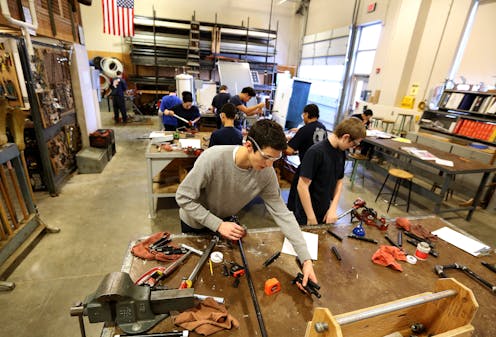Trump's big bet on career and technical education
- Written by Shaun M. Dougherty, Associate Professor of Public Policy & Education, Vanderbilt University

President Donald Trump has proposed[1] one of the largest increases in funding for career and technical education in recent history.
As a education policy researcher[2] who studies the economic and employment impact of career and technical education in high school, I believe this proposal has a lot of potential to open up new job opportunities, especially for students who might not want to go to college – or not right away.
My research [3] has found that the best investment in career and technical education is when it’s targeted toward schools that design all instruction around developing career paths, say, as an electrician or as a nurse’s assistant. Career and technical education can also improve[4] high school graduation and employment when it is integrated with core subjects and offers work-based learning.
Spending would double
The White House wants to nearly double[5] the total federal commitment to provide states with funds for career and technical education – from about US$1.2 billion in the current fiscal year to about $2.1 billion for fiscal 2021.
This proposal marks the first time in more than 20 years that the federal investment in career and technical education could change in a meaningful way after declining[6] for the last two decades.
For instance, in 2004, total funding through the Carl D. Perkins Act – the federal law that deals with career and technical education spending – was $1.7 billion[7]. By fiscal 2020 it had dropped to $1.2 billion[8]. Adjusting for inflation makes the drop even larger.
Student participation in career and technical education[9] had also declined during the era of No Child Left Behind, the 2002 federal law that required increasing the percentage of students proficient in math and reading by 2014. Meanwhile, an emphasis on testing dominated[10] education policy during the same time period, which maintained focus on tested subjects like math and reading, and less on career development.
The proposal also calls for allocating $83 million to competitive grants to states. Proposing competitive grants suggests that the administration will look to fund states with the most innovative proposals. This is in contrast to just giving out money based on how many students a state may serve, which is how most of the federal funds for technical education are allocated.
Trump also wants to double[11] fees associated with H1-B visas[12] – visas that allow for the hiring temporary workers from abroad with high skills that are in short supply in the U.S. This hike could raise an additional $100 million or more. The idea here seems to be to use revenue collected from programs that use talent from abroad to invest in educating students here in the United States.
Whole-school models?
Research[13] shows that students who take three or more courses in one career pathway earn more money in the decade after high school than similar students who did not take a group of related career and technical education courses.
This research[14] cannot fully explain why these earning gains occur. However, it could be that the specific skills[15] that students gain in career and technical education are likely to be rewarded with higher wages if those skills are in demand.
By comparison, the only technical education programs that research has shown[16] lead to improved graduation rates and higher wages are whole-school models.
Whole-school approaches to technical education are where all students participate in some form of vocational or technical education.
Most students have access to technical education at traditional high schools or centers[17] that are shared across school districts and where students spend part of their school day. This is the most common way students access technical education in the U.S. and where expansion is therefore most likely to occur. But, there is no strong evidence that these models are effective in improving high school graduation or employment or earnings after school. All of the best evidence comes from specialized high schools like those in Connecticut[18] and Massachusetts[19], or from career academies[20] which combine academic and technical coursework and organize it around a common theme.
But fewer than 5% of the nation’s students have access to a specialized career and technical education school[21]. If innovation grants were designed to induce increased access to specialized career and technical education high schools or high-quality career academies[22], it could be money well spent.
[Expertise in your inbox. Sign up for The Conversation’s newsletter and get a digest of academic takes on today’s news, every day.[23]]
References
- ^ proposed (www.whitehouse.gov)
- ^ education policy researcher (scholar.google.com)
- ^ My research (doi.org)
- ^ improve (www.brookings.edu)
- ^ nearly double (ctepolicywatch.acteonline.org)
- ^ declining (cte.careertech.org)
- ^ $1.7 billion (cte.careertech.org)
- ^ $1.2 billion (cte.careertech.org)
- ^ participation in career and technical education (nces.ed.gov)
- ^ dominated (chalkbeat.org)
- ^ double (www.ed.gov)
- ^ visas (www.dol.gov)
- ^ Research (www.educationnext.org)
- ^ research (www.brookings.edu)
- ^ specific skills (www.nber.org)
- ^ research has shown (www.brookings.edu)
- ^ high schools or centers (www.nmtcc.org)
- ^ Connecticut (www.cttech.org)
- ^ Massachusetts (www.valleytech.k12.ma.us)
- ^ career academies (www.mdrc.org)
- ^ access to a specialized career and technical education school (nces.ed.gov)
- ^ career academies (caldercenter.org)
- ^ Expertise in your inbox. Sign up for The Conversation’s newsletter and get a digest of academic takes on today’s news, every day. (theconversation.com)
Authors: Shaun M. Dougherty, Associate Professor of Public Policy & Education, Vanderbilt University
Read more https://theconversation.com/trumps-big-bet-on-career-and-technical-education-131558

